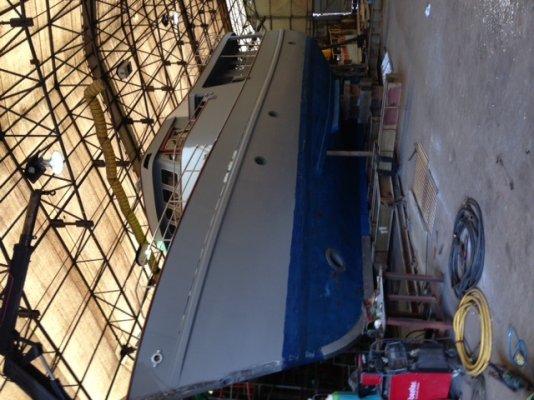1
.* Nobody's saying the engine can't do it, just that it can't do it very long.* A 1950s engine is a 1950s engine.** To think it can deliver the same longevity under hard use as a newer generation engine*is not a smart assumption except in the eyes of your diesel shop, which will love you for it.* The diesel shop we use has seen a lot of failed Lehmans over the years, and they told me not long after we bought our boat that in almost all cases the root cause of the failure was running them too hard, too fast, and too hot for too long.* Failed head gaskets were the most common specific cause of the failure they said.
Lehman created the FL120 in the mid-1960s.* At that time there were not a lot of engines on the market that would lend itself to this kind of conversion so their choices were limited.* Also, people viewed engine operation in the '60s considerably differently than they may do today.* Cruise rpm ranges for these engines were conservative.* Our owners manual itself does not call out any specific cruise power--- it simply says (verbatim)*"Cruising rpm varies with the conditions and type of engine fitted.* Please check with your dealer for his recommendations."* Our manual includes a separate page from the GB dealer who sold the boat new in 1973.* The page contains a list of operating and maintenance recommendations and intervals.* Under "recommended cruise power" it says 1600 to 1800 rpm.*
2.* You're right but....* I see "rpms" used in print*to mean a range of rpm.* What's plural is not the word*"minute" but the whole acronym.* So it means "more than one specific rpm."* But.... just because I see the term "rpms' used by various motoring journalists doesn't mean it's correct.* It may just mean that we're all wrong
There where options but maybe a money question. I know that the OM 352 engine is a proven power-plant for over decades and still produced in for example Brasil.
The OM 352 engine introduced at the 1964 Geneva Motor Show by Mercedes-Benz
The Mercedes Benz OM352 Engine is a 5675 cm3 (5.7 litres, 345-cubic-inch) displacement inline 6-cylinder 4-stroke Diesel engine. It is one of many motors in the 300 series of engines, which were developed during and after World War II, while specifically the OM352 was revealed in 1964. The OM352's lineage can be traced back to the OM312, itself an 80HP inline-six engine.
[1] The OM352 has many applications, including marine, military, municipal, and agricultural vehicles, as well as stationary settings. The engine has differing trim and power levels, affording designations such as OM 352A a variant fitted with a turbocharger, or the OM 352LA, which is fitted with an intercooler and a turbocharger. (List of Mercedes-Benz engines.)
The engine is water-cooled, and is produced using cast-iron cylinder block, with cast-in cylinders. The engine utilizes diesel fuel delivered in a direct injection method from a Bosch PES style inline injection pump. The cylinder head is a single unit for all cylinders, and the cylinder head cover and air intake are shared by a single cast aluminum alloy. Interestingly, exhaust ports 2&3 and 4&5 are siamesed together, presenting an exhaust manifold with only four outlets.
The crankshaft is a precision forged unit running in seven three-layer bearings, with counterweights bolted onto the crank webs, much like any other diesel motor of its vintage. The middle bearing is also the thrust bearing. The connecting rods are of a split design, with bronze bushings for the piston pin.
The OM 352 was also one of many Mercedes engines licensed in 1979 for manufacture by Atlantis Diesel Engines (ADE) in South Africa. These were known as ADE 352 and are virtually identical to the Mercedes engines.Recently the OM 352 was licensed by TATA for use in their 713S Trucks. These are manufactured by TATA but however have slight differences like the weights no longer being bolted to but rather part of the crank and no holes for oil sprayers in the block. These modifications are likely to reduce complexity and cost of engine production.
Common output power can vary from 92 kW to 141 kW (126 to 192 hp) depending on the fuel delivery and air charge options. Higher output can be achieved through special modifications, however engine longevity may be affected with such non-factory modifications.
Improved engines developed after the OM352 include the OM366, which looks extremely similar in appearance. Due to emissions requirements, the 300 series engines were eventually retired. Mercedes Benz 900 series engines are the successors of motors such as the OM352


